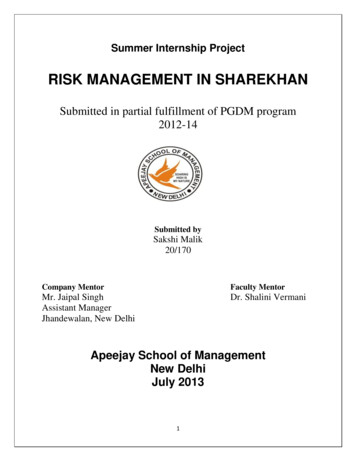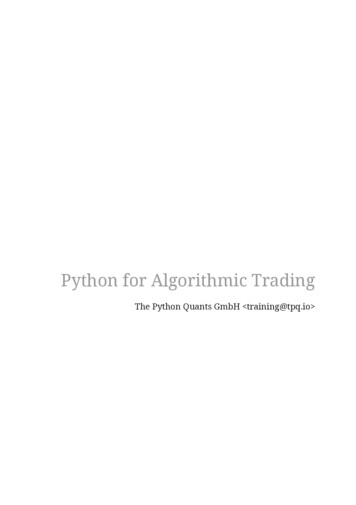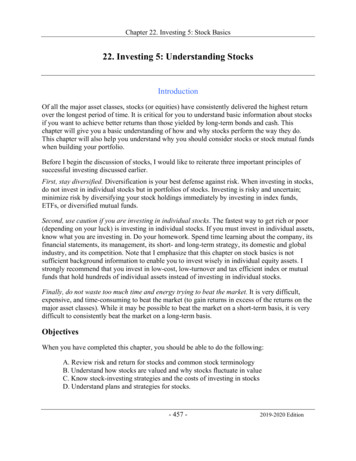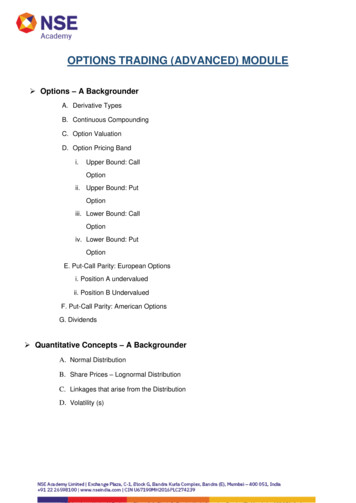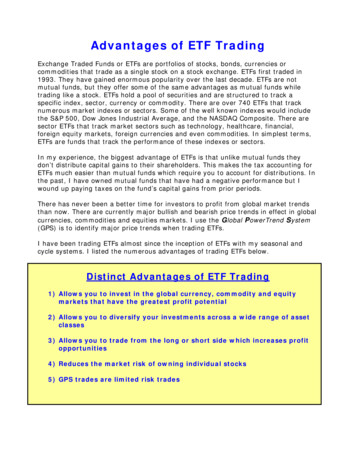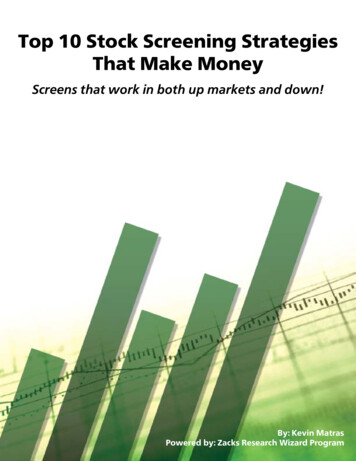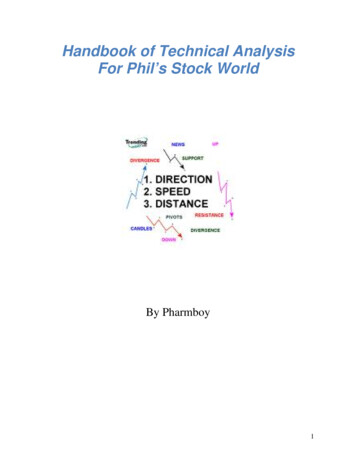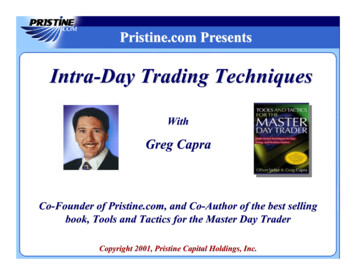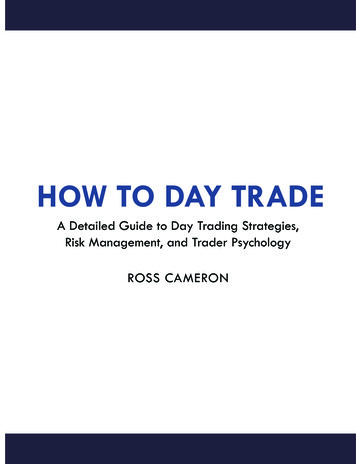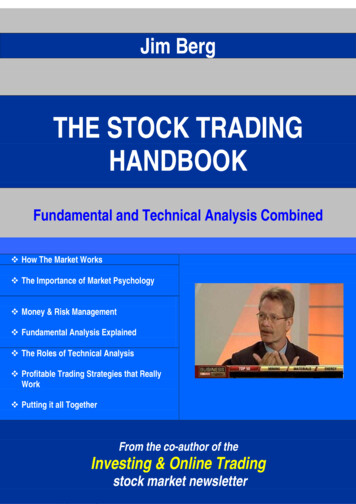
Transcription
Jim BergTHE STOCK TRADINGHANDBOOKFundamental and Technical Analysis Combined How The Market Works The Importance of Market Psychology Money & Risk Management Fundamental Analysis Explained The Roles of Technical Analysis Profitable Trading Strategies that ReallyWork Putting it all TogetherFrom the co-author of theInvesting & Online Tradingstock market newsletterCopyright Jim Berg 20091
The Stock Trading HandbookCopyright Jim Berg2Acknowledgements: The author would like to thank Paritech and Justdata for theirpermission to reproduce selected screenshots. Also a special thanks to Louise Bedford, ZdenkoSimonic, Dr Brett Steenbarger, John Atkinson and Tim Wilcox for their contributions.First Published 2002 by Wrightbooks as ‘The Share Trader’s Handbook’.5th Edition June 2009 by www.ShareTradingEducation.comThis is an updated version of the first publication.DisclaimerDirect investing in the stock market can result in financial loss. Historical results are noguarantee of future returns. No representation is being made that any account will or is likelyto achieve profits or losses similar to those shown. Stock tips or ‘buy’ or sell recommendationsare not provided.This educational information is not designed to replace your Licensed Financial Consultant oryour Stockbroker. It has been prepared without regard to any particular person's investmentobjectives, financial situation and particular needs. This information is of a general nature onlyso you should seek advice from your broker or other investment advisors as appropriate beforetaking any action.The decision to trade and the method of trading is for the reader alone to decide. Any lossesthat are incurred are the sole responsibility of each trader and investor. The authors of thisebook, Avestra Capital Pty Ltd (“Avestra”) AFSL 309743, and ShareTradingEducation.com(“STE”), as Corporate Authorized Representative of Avestra, disclaims all liability of theauthors, Avestra, STE and its Associates for any loss or damage suffered by any person byreason of the use by that person of, or their reliance on any information contained herein,whether arising from the negligence of the authors, Avestra, STE or its Associates or otherwiseAll reasonable steps and due diligence have been taken inmay contain ideas and reference to trading instruments thatstyle of investing or trading. So it is up to you to do yourconclusions. By itself, this document will not enhance yournor will it prevent you from incurring losses.preparing this ebook. However, itare not appropriate to you or yourown research and draw your owninvesting or trading performance,Please also refer to the disclaimer at the back of this ebook and our Terms of Use.CopyrightThe information contained in this publication is copyright and for the sole use of readers whohave purchased it or who have received it as part of their seminar registration. All rightsreserved. No part of this publication may be reproduced, copied or circulated to other readers.Each issue incorporates fingerprint protection that enables us to track the original source ofpirate copies. Offenders may be prosecuted.Disclaimer: Direct investing in the stock market can result in financial loss. Historical results are no guarantee of future returns. Norepresentation is being made that any account will or is likely to achieve profits or losses similar to those shown. Stock tips or ‘buy’ or sellrecommendations are not provided. This educational information is not designed to replace your Licensed Financial Consultant or yourStockbroker. It has been prepared without regard to any particular person's investment objectives, financial situation and particular needs. Thisinformation is of a general nature only so you should seek advice from your broker or other investment advisors as appropriate before taking anyaction. The decision to trade and the method of trading is for the reader alone to decide. Avestra Capital Pty Ltd (“Avestra”) AFSL 292464, andShareTradingEducation.com (“STE”), as Corporate Authorized Representative of Avestra disclaim all liability of Avestra, STE and its Associates forany loss or damage suffered by any person by reason of the use by that person of, or their reliance on any information contained herein, whetherarising from the negligence of Avestra, STE or its Associates or otherwise. Refer also to our Terms of Use.JBEbook090610Aa
The Stock Trading HandbookCopyright Jim Berg3CONTENTSForeword by Louise Bedford4Introduction5Chapter 1 How the Market Works8Chapter 2 Taxation, Financial Planning & Choosing a Broker23Chapter 3 Market Psychology43Chapter 4 Fundamental Analysis68Chapter 5 Technical Analysis – Charting75Chapter 6 Technical Analysis – Indicators97Chapter 7 Money Management, Exits and Position Sizing114Chapter 8 Profitable Trading Strategies that Really Work134Epilogue166Bibliography168Glossary168Jim Berg’s Trading Tools169Disclaimer: Direct investing in the stock market can result in financial loss. Historical results are no guarantee of future returns. Norepresentation is being made that any account will or is likely to achieve profits or losses similar to those shown. Stock tips or ‘buy’ or sellrecommendations are not provided. This educational information is not designed to replace your Licensed Financial Consultant or yourStockbroker. It has been prepared without regard to any particular person's investment objectives, financial situation and particular needs. Thisinformation is of a general nature only so you should seek advice from your broker or other investment advisors as appropriate before taking anyaction. The decision to trade and the method of trading is for the reader alone to decide. Avestra Capital Pty Ltd (“Avestra”) AFSL 292464, andShareTradingEducation.com (“STE”), as Corporate Authorized Representative of Avestra disclaim all liability of Avestra, STE and its Associates forany loss or damage suffered by any person by reason of the use by that person of, or their reliance on any information contained herein, whetherarising from the negligence of Avestra, STE or its Associates or otherwise. Refer also to our Terms of Use.JBEbook090610Aa
The Stock Trading HandbookCopyright Jim Berg4ForewordWhen I initially started speaking on the share market lecture circuit, I kept hearing about aman called Jim Berg. In this surprisingly small industry, when a true professional cements hispresence, it doesn’t take long for the word to travel. All that I ever heard in relation to Jim waspositive.I decided to investigate. As I found out, Jim Berg is a former broker, private trader andlecturer with over 20 years experience in the investment industry. Jim has appeared on CNBCAsia and Market Wrap and has been a guest speaker at the Australian Stock Exchange, theSydney Futures Exchange and the Australian Technical Analysts Association. After hearing allof these rave reports, I finally met the man and we immediately developed a good friendship.Jim’s obvious credentials complement his passion for training. Not only does he have theknowledge about how to trade effectively, but Jim also has the rare gift of being able to imparttrading concepts in ways that have helped both novice and experienced traders alike. Jim wasa schoolteacher for eight years before embarking on his career in the stock market, and it isclear that his teaching qualification and former experience have stood him in good stead.Jim combines the fields of fundamental and technical analysis. This method is growing inpopularity as a result of several market events, including the tech wreck and high-profileliquidations such as that of HIH. Using tools and trading strategies demonstrated in hisinvestment workshops and seminars, Jim recently returned an annualized 27.5% in fivemonths of trading in the Personal Investor Sharetrader’s Showdown for 2001. This was in theuncertain market conditions that eventuated in the All Ords only gaining 6% in the same year.This is just one piece of evidence that Jim’s methods are effective.The Stock Trading Handbook is a comprehensive, practical guide inspired by Jim’s years ofexperience. If you are after a no-nonsense easy-to-follow, direct book that will help you getstarted trading the markets by combining fundamental and technical analysis, then this is thebook for you.Louise Bedfordwww.tradingsecrets.com.auLouise Bedford is the author of the bestselling books Trading Secrets, The Secret ofCandlestick Charting, The Secret of Writing Options and Charting SecretsDisclaimer: Direct investing in the stock market can result in financial loss. Historical results are no guarantee of future returns. Norepresentation is being made that any account will or is likely to achieve profits or losses similar to those shown. Stock tips or ‘buy’ or sellrecommendations are not provided. This educational information is not designed to replace your Licensed Financial Consultant or yourStockbroker. It has been prepared without regard to any particular person's investment objectives, financial situation and particular needs. Thisinformation is of a general nature only so you should seek advice from your broker or other investment advisors as appropriate before taking anyaction. The decision to trade and the method of trading is for the reader alone to decide. Avestra Capital Pty Ltd (“Avestra”) AFSL 292464, andShareTradingEducation.com (“STE”), as Corporate Authorized Representative of Avestra disclaim all liability of Avestra, STE and its Associates forany loss or damage suffered by any person by reason of the use by that person of, or their reliance on any information contained herein, whetherarising from the negligence of Avestra, STE or its Associates or otherwise. Refer also to our Terms of Use.JBEbook090610Aa
The Stock Trading HandbookCopyright Jim Berg5IntroductionThe Penguin English Dictionary describes a handbook as a guide-book. The Stock TradingHandbook will guide the beginning trader through the difficult process of applying indicators ina trading system that combines fundamental and technical analysis. This is a manual disguisedas a book. It contains information on trading and important related issues that could affectinvestment decisions.The aim of this handbook is to help those inexperienced at trading shares to understand theshare market and take the first steps to investing successfully. There is a vast amount ofinformation available on markets and investing.To put all this information in one book would intimidate by its volume. There are entire bookswritten on many of the topics presented in these pages. The beginning trader can use thisbook as a starting point to learn the basic investment concepts and explore each in greaterdepth when it is more appropriate and convenient.This ebook is not just for beginners. For experienced readers, more advanced topics, arecovered, with the intention of helping traders improve their performance in the market.An investor can buy and sell shares over a short-, medium or long-term timeframe. Theprocess of buying and selling shares is called trading. Every investor is thus a trader, to anextent. A narrower definition of a trader would be someone who buys and sells shares on afrequent basis for capital gains rather than infrequently for income.For the purposes of this book, the words ‘investor’ and ‘trader’ are used interchangeably.Equally, while we discuss ‘shares’ and share market’, most of the principles in this ebook canbe applied to ‘stocks’ and ‘stock markets’ around the world - so these words can also beinterchanged.In this ebook, and our weekly newsletter, we stress the importance of psychology, money andrisk management, as well as providing profitable trading strategies which use both technicaland fundamental analysis combined. By mastering these, investors and traders increase theirchances of long term survival and profitability in the market.Some investors rely on a company’s fundamental performance to make their investmentdecisions. Other traders ignore fundamental analysis and rely completely on charting andtechnical indicators. Technical analysts reason that everything worth knowing about a companyis reflected in the current price action.My trading strategy combines fundamental and technical analysis as weight-of-evidence toimprove the probability of success in the market.Chapter 1 contains a brief explanation of why the share market exists and how it works.Market influences and several different styles of investing are also examined.Chapter 2 provides information on taxation in relation to share trading, financial planning, DIYSuper Funds and the difficult decision of whether to trade online or with a full service broker.We also discuss the benefits of using a broker assisted conditional ordering facility.Chapter 3 focuses on investor psychology and will help beginning traders understand how anindividual’s personality and beliefs can sabotage their trading.Disclaimer: Direct investing in the stock market can result in financial loss. Historical results are no guarantee of future returns. Norepresentation is being made that any account will or is likely to achieve profits or losses similar to those shown. Stock tips or ‘buy’ or sellrecommendations are not provided. This educational information is not designed to replace your Licensed Financial Consultant or yourStockbroker. It has been prepared without regard to any particular person's investment objectives, financial situation and particular needs. Thisinformation is of a general nature only so you should seek advice from your broker or other investment advisors as appropriate before taking anyaction. The decision to trade and the method of trading is for the reader alone to decide. Avestra Capital Pty Ltd (“Avestra”) AFSL 292464, andShareTradingEducation.com (“STE”), as Corporate Authorized Representative of Avestra disclaim all liability of Avestra, STE and its Associates forany loss or damage suffered by any person by reason of the
The Importance of Market Psychology . trading concepts in ways that have helped both novice and experienced traders alike. Jim was a schoolteacher for eight years before embarking on his career in the stock market, and it is clear that his teaching qualification and former experience have stood him in good stead. Jim combines the fields of fundamental and technical analysis. This method is .

